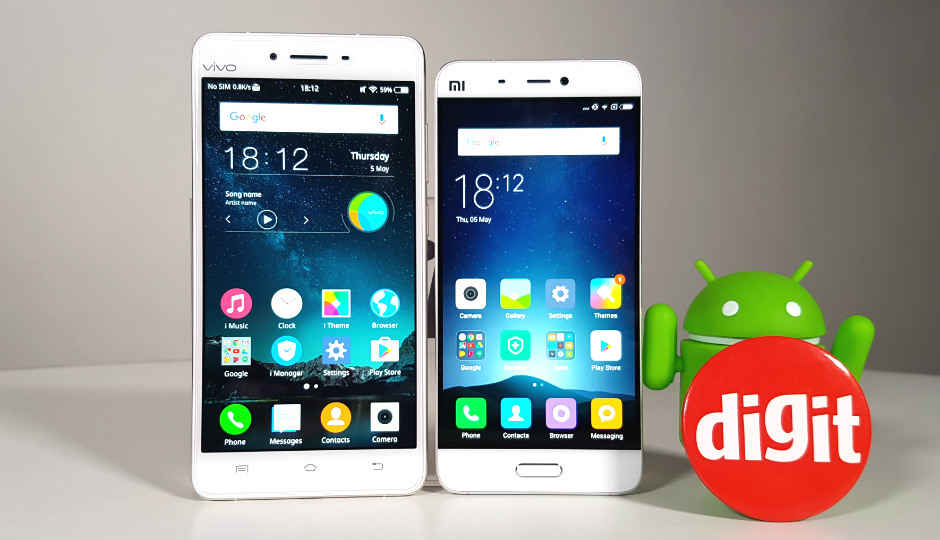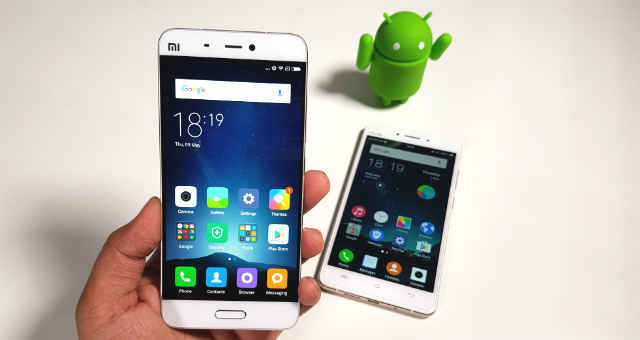Comparison: Xiaomi Mi 5 v. Vivo V3 Max
Snapdragon 652 vs Snapdragon 820. The sub-25 grand face-off.

The smartphone world has evolved to a point where a budget of Rs. 25,000 is now deemed enough to get you a very competent overall package. On this light, two particular smartphones have garnered enough potential to call us out for a shootout. We have with us the Xiaomi Mi 5 and the Vivo V3 Max – each of which are fine devices in their own right. This very aspect led us to compare multiple aspects of the two devices, and find out the pros and cons of each. We speak about the individual builds, designs, displays, performance, and finally the cameras that each of these devices house.
 Survey
SurveyNot too long ago, we came across the latest smartphone sales figures in terms of brands. While Xiaomi dropped out of the top five, Vivo was the latest entrant in the list. In accordance, you would expect Vivo to be firing hard at the market with their smartphones. The story, however, is rather different for these two devices, in particular. While Xiaomi’s Mi 5 was widely anticipated (to the point of frustration, for many) and launched amid much fanfare, the Vivo V3 Max did not exactly scale such heights of interest upon launch. Both the devices claimed rights of being the first in India with the chipsets they use. The Mi 5 was the first to bring the Snapdragon 820 chipset to India, while the Vivo V3 Max became the first to bring the Snapdragon 652.
Unfortunately, the hard truth is that even if a chipset is powerful enough to perform without any hiccup whatsoever, it will always garner lesser excitement in comparison to its flagship compatriots. The Snapdragon 652 SoC sits right underneath the commendable Snapdragon 820, and as a result, misses out on some of the notable innovations that have been marked on the flagship processor. The Snapdragon 820 uses Qualcomm’s custom Kryo cores in a quad-core layout, along with a separate digital signal processor (the Hexagon 680 DSP) to tackle background tasks, the advanced X10 LTE modem monitored by Qualcomm’s Zeroth engine that lends machine learning capabilities in terms of network usage, and multiple other innovations.
The Snapdragon 652, in face of such innovations, understandably fails to hold similar value both in terms of innovation and interest. In light of this, we move to our first factor of comparison:
Performance
While my introduction to the story very much sums up the status of performance here, there is still more to talk about. The Snapdragon 820 that resides inside the Mi 5 has been clocked down to 1.8GHz. Additionally, much of the optimisations that Qualcomm has done with the Snapdragon 820 resides on its internals, and you might not see a direct reflection of it in your daily usage.
That said, there are aspects where the Snapdragon 820 shows its class over the Snapdragon 652. For instance, when you’re moving across your office premises and shift across different WiFi networks, the Xiaomi Mi 5 automatically switches to the next registered WiFi network on the device, based on dependable signal strength. The Vivo V3 Max takes longer in switching between networks, and spends a while in selecting the best network. While this does not really hamper usage, and you may not even realise it on everyday usage, it preserves battery levels on overall terms, alongside streamlining downloads. If you’re downloading a large file on the go, the Mi 5 streamlines downloads in a way that your activity will not be interrupted because of the device searching for the best network. The Xiaomi Mi 5 seamlessly switches between WiFi networks and data, saving you valuable chunks of data. These are the aspects that the Vivo V3 Max misses on.
In terms of daily usage, both the devices are very competent, with no lags whatsoever in terms of everyday apps. While gaming, the smaller display size of the Mi 5 coupled with the flagship-class Adreno 530 GPU gives higher frame rates. The Vivo V3 Max is powered by the Adreno 510 GPU, which does get support for OpenGL ES 3.1 + AEP (Android Extension Pack), Renderscript, Vulkan, and OpenCL 2.0. It is highly competent in terms of support and performance power, but the Snapdragon 820 package is simply better, and more powerful.
The benchmark scores reflect the difference that lies between the two smartphones. The Xiaomi Mi 5’s performance is not the pinnacle that Snapdragon 820 can reach. Instead, it is subtly optimised to save on power consumption while maximising performance output. Vivo, too, has kept two cores locked unless you’re putting heavy loads on the device. The difference in the class of performance between the two devices show when you are playing games, or multitasking for prolonged periods, or even switching between data and WiFi networks amid short spans of time.
All of these combine to make the Xiaomi Mi 5 the undisputed better performer here. The Vivo V3 Max will still suffice most users’ needs and excel in most circumstances, but simply does not have the oomph that the pompous Mi 5 can boast of.
Camera
This one’s a question of being the lesser evil. Neither of the camera modules bring the excellence that present generation flagships like the Samsung Galaxy S7 Edge or the iPhone 6s Plus bring with themselves. Both render visible amounts of noise in the photographs they shoot, the colours are not the most accurate, and on the overall note, both are far from being the best around.
While the Xiaomi Mi 5 tends to oversaturate photographs, the Vivo V3 Max trumps it by being closer to the original colours in photographs. The Mi 5, however, makes up by shooting sharper images in comparison, in decent lighting conditions. It also packs in higher levels of contrasts, although the flatter tone in the Vivo V3 Max will leave more room for image filters without making photographs appear rather unnecessarily post-processed on social media.
In low light situations, both the camera fall flat on their faces. The Xiaomi Mi 5 can still discern objects in low light conditions, but the resultant photographs shoot up the amount of grain to the point where it distorts colours. The Vivo V3 Max does not do that, but neither does it manage to depict the subject with even reasonable amount of discernibility. Take a look at our image samples to see the difference between the two.
We would give the Mi 5 the edge here, but ideally, neither of the cameras shoot photographs that you would be too proud of.
Note: Images on the left are for Vivo V3 Max, on the right for Xiaomi Mi 5. Click on the images to enlarge.
Display
The tale here is absolutely different – both the devices have good display panels that deliver crisp contrast and sharpness levels. Both the smartphones use 1080p Full HD panels, and both are amply bright and reasonably good for outdoor usage. The Vivo V3 Max does have a very marginal shift in hue at very acute angles, but that will almost certainly not hamper your regular usage. It, however, takes the cake by being the warmer of the two panels, although you can easily fine tune the colours on the Xiaomi Mi 5 according to your preferences.
Build, Design and Ergonomics
The Xiaomi Mi 5 wins here, and very visibly so. As we stated in our review, the Xiaomi Mi 5 is too ergonomic, with the curved edges on its rear panel, the incredibly compact footprint, and the overall goodness that you associate with a flagship device. It is also quite the looker, and creates an impression of finesse upon first sight.
The Vivo V3 Max, meanwhile, is large, heavy, bulky, and houses a 5.5-inch display panel that is too large to hold. Sure, Vivo’s FunTouch OS does allow one-handed mode, but if a device is too large in itself, UI optimisation can only help you marginally. There is also nothing exceptional to mention about the looks here, and you can be forgiven for thinking that the Vivo V3 Max is yet another average smartphone in the block.
Bottomline
The Xiaomi Mi 5 is definitely the better device in terms of looks, ergonomics and performance. Neither have good camera modules, while both pack in good display panels. The price points, however, is the key here. The Vivo V3 Max would have been recommendable had it been priced at around Rs. 16,000. But, at Rs. 23,980, it is barely Rs. 1,000 lesser than the Xiaomi Mi 5.
With the Mi 5 being the overall champion, there is barely any reason for you to go for it. The Vivo V3 Max would have been a story of success, if priced more competitively, and while the Mi 5 itself has been called overpriced in terms of initial consumer expectations, it is here that it shows its class.


















